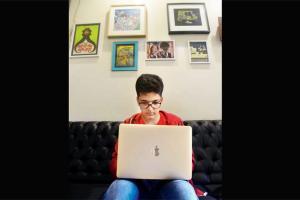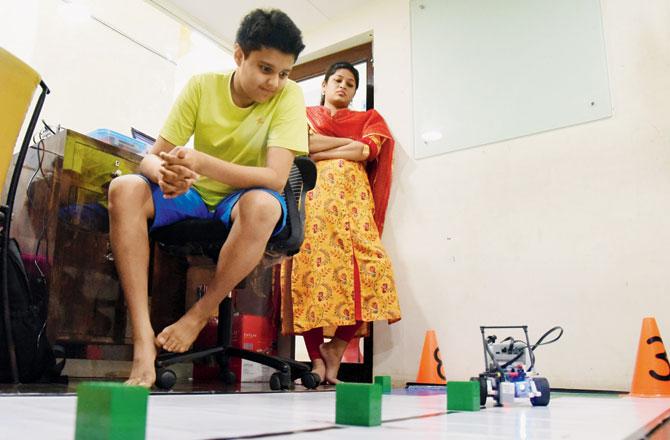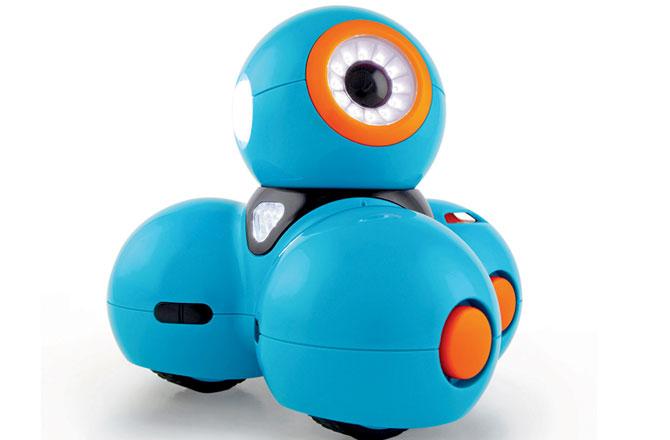With coding being linked to high creativity and logical thinking, parents are taking kids, some as young as four, for classes even before they learn English

Shaurya Sharma, 13, a student of Bombay International School created the Fortnite Win Prediction app. He joined WhiteHat Jr in January at the insistence of his mother. Pic/Atel Kamble
On a Tuesday evening, while Mumbai was bathing in a pre-monsoon shower, we were enjoying the luxury of being on a cloud — albeit a virtual one. Staring at us, on our desktop screen, were engineer Abhilasha Naidu and 13-year-old Joe Swarya Pidakala, both from Bengaluru. The duo is on WhiteHat Jr, a recently-launched live online 1:1 coding platform for kids aged six to 14. During the hour-long class, Pidakala was seen creating a basic pong — a two-dimensional sports game that simulates table tennis — with Naidu, his teacher, helping him achieve the task. This writer, on the other hand, was the observer: Watching without participating, like a disinterested student, yet quite not.
ADVERTISEMENT
Every now and then, Naidu nudged Pidakala to think out of the box, and write the best possible command codes — not as complex as html, C or C++ — to create dynamic sounds, or to make animation, so that his player looked more human. By the end of it, we had a fully-functional pong, which incidentally had the sensibility of a football game, because Pidakala aspires to be a footballer, and he'd "rather create something that is closer to his interest".

Shivraj Shah, 12, a Bombay Scottish School student uses a block programme, Lego Mindstorms, to get his robocrane to move forward and grab objects. But, what coding has also helped him with is mathematics. "Earlier, I used to be weak in maths, but I think I caught on to it after I started coding." Pic/Nimesh Dave
The teenager is among a growing tribe of children, who are slowly warming to coding, a combination of sequence, structure, commands and algorithmic thinking, which educationists in the technological space, believe can enhance creativity and logical thinking. In Mumbai, Edutech platforms like WhiteHat Jr, and CS-S.T.E.A.M. (Computer Science, Science, Technology, Engineering Art & Math) schools and community spaces like Kids Techie Club, Maker's Asylum and On My Own Technology are among the few, that are spearheading the movement.
It is a playground
Karan Bajaj, writer and founder-CEO of WhiteHat Jr, whose platform sees 3,000-plus online classes daily says that coding is the need of the hour. "Before the industrial revolution, mathematics was being taught in less than five per cent of the schools. And then the industrial revolution happened, and it became a core subject in the curriculum of every school. I thought that since we were in the middle of the computer revolution, the same thing should happen with coding as well. Unfortunately, schools right now, don't have a structured curriculum around it," says Bajaj.

Steve Jobs
He points out to research by NASA, about how kids are at their most creative at age five, after which, with every proportionate decade, their creativity drops by 50 per cent. "By the time, they reach adulthood, they are a fraction of their instinctual, creative powers. If you question why that happens, it is because almost every subject we teach in school is binary — it's either right or wrong. Coding or programming is not. It is about putting blocks together to create anything and everything. Coding is a vast playground."
At coding schools, six-year-olds are using codes to create spelling bees and teens are designing online games. As the coding gets complex, you can also use it to make web-based apps, engineer robots and drones, and in the field of AI. "For a kid, it's a delightful experience, because they become makers and creators at a very early age," adds Bajaj. Computer Scientist Gauri Parulkar, who has created and designed the curriculum at WhiteHat Jr, says syntax (programming language) is not as important as logic, when using coding. "Let's say there is a maze, and a creature has to navigate it by 'going straight-going up' five times. While you can write a lengthy command, where you type 'go straight' and 'go up' five times each, we teach kids to identify a pattern, wherein if the task is repeating, you simply multiply the same command by five, to achieve the desired result. This is logic."

Karan Bajaj
Shruti Suyog Nar, who started Kids Techie Club nine years ago, when programming was a subject restricted to engineering schools, runs a "coding for toddlers" class, primarily for four years olds. "Kids of this age group are usually not exposed to the screen or laptop. So, we use a kit for them, which uses screen-less coding that helps them understand how to give instructions to a particular machine, in order to make it behave in a certain manner." The kit comprises a robot and a set of physical blocks, where each block defines a function — move forward, take a turn or go straight.
"They are given a challenge mat, where the robot is seen going on an adventure trail. What they have to do is give the robot certain instructions using the blocks to navigate the path, so that it can complete the trail," says Nar. She feels that "this play-and-learn environment will help kids develop their motor-mechanical skills and concentration levels" at an early age. The growing popularity of the subject has also gotten schools to take notice. In the last two years, JBCN International School and Aditya Birla World Academy among others, have incorporated coding in their academic curriculum.
What makes Jack a dull boy?
At 13, Shaurya Sharma of Bombay International School, Babulnath, is like any other teenager. He can spend hours playing video games. When his mum Sonu enrolled him for a class at WhiteHat Jr, she remembers him throwing a tantrum. "Initially, I thought this was a lot like the html coding we did in school to create websites, and wasn't too keen on it," he says. Sonu adds, "I figured that if he was spending time on the computer, he might as well use it constructively to create something."
In April, Sharma created a Fortnite Win Rate Calculator app, on a third-party developing platform Thunkable that went live on Google PlayStore. Fortnite Battle Royale is an online, survival game where players skydive onto an island and scavenge for gear to defend themselves from other players. The game has reportedly been downloaded more than 40 million times. Sharma created the app, because win rates — number of wins — on Fortnite were discussed very often among his friends in class.
The fact that his friends have downloaded his app, makes him feel like the exercise was fruitful. Apart from this, Sharma has also created a Body Mass Index Calculator, where one needs to feed in their weight and height to find out if they are normal, overweight or obese. "While the coding I learnt is not as precise as html, you have panels and blocks [on the platform] to help you give commands; the computer only accepts these commands, if it's correct. So, it's based on a lot of trial and error." WhiteHat Jr has uploaded a host of other apps created by its students on PlayStore. One of the recent ones to go live was by Safal Sawant, a Class V student, who developed the
Dr APJ Abdul Kalam app, which includes a biography of the late scientist, and a compilation of his quotes, books and awards.
Then, there are others, who are using coding in robotics. Twelve-year-old Shivraj Shah, who studies at Bombay Scottish School, Mahim, recently did a 10-day coding course with friends. "But, I just learnt the language, and wasn't able to see the practical purpose of it." At Kids Techie Club, he now, uses a block programme, Lego Mindstorms, to get his robocrane to move forward and grab objects. "Because, I know the language, I am able to comprehend the speed and the way the robot will turn. Otherwise, I would have been clueless," he says, adding that coding has helped him see maths in a different light. "I used to be very weak in the subject, but I think I caught on to it after I started coding."
A 21st century skill
It's not for nothing that the late Apple founder Steve Jobs had insisted that everyone learn to programme a computer. "It teaches you to think. At its core, programming is about problem solving — thinking logically and breaking down a problem into steps to find a solution," he had said. Dr Gauri Kirtane Vanikar, specialist senior consultant with non-profit FSG, says that coding is like any language, that you need to learn and master, to consume and express yourself.
"First, it helps you become creative, because, the moment you start expressing, you also learn to create; coding gives you a platform to use your language in a way that you can put your idea into action. For instance, you may have thought of a game or a challenge, but for this you need to be creative, because this idea has to be new or stand out from what already exists." Once the idea is created, the kid breaks down the steps to implement it. "Here, they have to sequence the different things that will go into creating the end product, after which they'd need to code it, and then do a trial. If there is a glitch, the kid will have to take a step back, and problem solve."
This is where Dr Vanikar discusses the concept of executive function, which she says is today, valued more than IQ. "The executive function comprises cognitive flexibility, where you have approached a problem, and the solution may not work. The skill here would be to learn to be flexible enough to think of an alternative solution. So, there's testing, problem solving and revising to create a finished product, and that's why coding pushes a child." She, however, says screen-time for kids younger than five, isn't a great idea. For everything else, there is a toy.
3,000
The number of classes that WhiteHat Jr conducts daily
Toys to teach kids coding

Cubetto Ages: 3-6
Cubetto is a Montessori approved wooden robot that can teach your child the basics of computer programming. The kit comprises of a robot and wooden coding blocks that can be placed on the control board to form a sequence of events. Once you hit the blue button and Cubetto executes the motion. All this without resorting to a screen.

Cue Ages: 11+
Cue is a cute little toy that can be programmed to do whatever you want. Kids can choose to programme it with the drag and drop programming blocks method or through the toys Wonder programming system or directly with Javascript. This lets the Cue be more versatile allowing everyone from a novice to a veteran programmer take charge of its systems.

Osmo Coding Awbi Ages: 5-12
Osmo is a small device that attaches to your iPad allowing it to detect hands and other objects around it. The Coding Awbi kit lets the kid use a set of blocks to programme and control an on screen character to do everything from collecting fruits to interacting with other creatures in the forest. It is a very simple and tactile way to learn programming.
- Jaison Lewis
Catch up on all the latest Mumbai news, crime news, current affairs, and also a complete guide on Mumbai from food to things to do and events across the city here. Also download the new mid-day Android and iOS apps to get latest updates
 Subscribe today by clicking the link and stay updated with the latest news!" Click here!
Subscribe today by clicking the link and stay updated with the latest news!" Click here!






